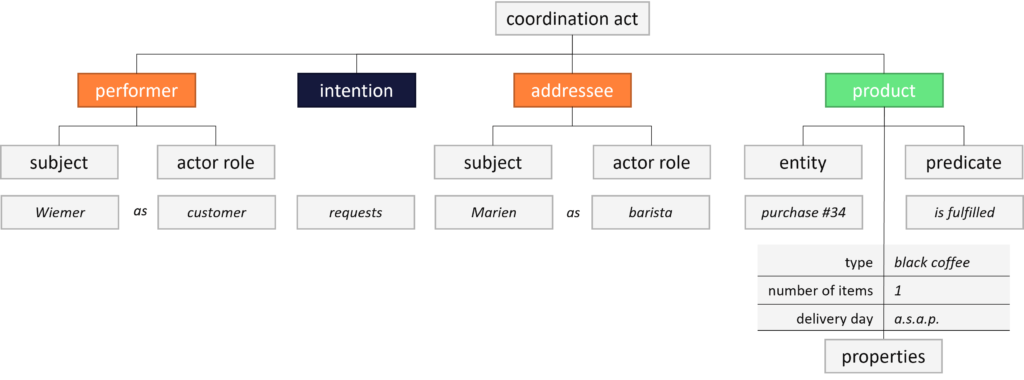In a previous blog, I showed that every activity in an enterprise is part of a transaction, and that every transaction regards some (desired) product, surrounded by the necessary interactions, called coordination. A transaction involves two actors (human beings): the one that is interested in (getting) the product, the initiator, and the one responsible for creating or delivering the product, the executor. The basic transaction pattern shows that a successful transaction comprises (at least) four coordination acts and one production acts: request-promise-execute-declare-accept. In order to further clarify the concept of the transaction pattern, I will analyze an example business interaction in terms of this pattern. Building upon this analysis, I will detail the contents of each coordination act.
Example
Let’s start with an example:
Wiemer: “I would like a cup of coffee”
Marien: “Sure, I will get it right away”
In the first sentence, Wiemer requests to Marien the production of ‘cup of coffee is delivered’. In the second sentence, Marien promises to Wiemer the production (and delivery) of the cup of coffee.
Now, supposed that Marien knows what kind of coffee Wiemer wants, or only offers one kind of coffee, he will proceed to making the coffee. Marien thus performs the execute.
When the coffee is ready, Marien puts the coffee on the table, next to Wiemer. Wiemer is busy with some Mendix project and hardly notices the coffee has been served. In order to make sure Wiemer knows the coffee is ready, Marien supports his statement:
Marien: “There you go”
After which Wiemer nods and continues working.
The act of Marien putting the coffee on the table, can be considered as declare. Non-verbal acts can act as coordination as well. In order to make sure that Wiemer has received the declaration, Marien supports it with a verbal act. Wiemer nodding can be considered the act in which he accepts the product, although he may only later find out that the coffee is not as warm as expected; inspection of the product and a verbal accept is therefore the preferred way to perform an acceptance.
Business Conversations
The example above can be considered too simple and non-business related. However, if we replace the coffee by some (important) report, a travel reservation or a verdict, it becomes apparent that all business conversations can be analyzed into one or more of such transactions. We say ‘more transactions’, as it is quite common in business there is some counter transaction involved. In the coffee example, a commonly related transaction regards payment. Relating or composing transactions will be explained in a future blog.
Moreover, in real-world business conversations, it is common to define more properties or characteristics of the product, such as the type of coffee (black, with milk, cappuccino, etc.) or the cup size, or even the temperature or the time frame within which the resulted is expected. This is best explained by formalizing the structure of the coordination act.
Formalizing the Coordination Act
We can further structure the coordination acts from the example as follows. We leave out the production (execute) act in order to focus on the coordination (communication) only.
- Wiemer requests to Marien ‘cup of coffee has been delivered’
- Marien promises to Wiemer ‘cup of coffee has been delivered’
- Marien declares to Wiemer ‘cup of coffee has been delivered’
- Wiemer accepts to Marien ‘cup of coffee has been delivered’
Now it becomes apparent there is a structure behind these sentences, that we can further formalize: a coordination act consists of four components:
- The performer: the person who performs the act;
- The intention: request, promise, declare, or accept – later we will see there are a few more possibilities to facilitate exceptions;
- The addressee: the person to which the act is directed; and
- The product: the product that the transaction is about.
In order to further formalize this, we denote both the performer and the addressee as a subject in some role. Moreover, the product is formulated as some entity (e.g., purchase #34) and a predicate (e.g., is fulfilled), that can have additional properties. This allows for further abstraction to easily distinguish the ‘purchase’ of Wiemer on one day from his purchase on another day, or from a purchase made by someone else.

Benefits of Using the Structured Coordination Act
The main benefit of this structure is that it fits all coordination acts. As an example we provide the other coordination acts in the structured format as well:
- Marien, as barista, promises (to) Wiemer, as customer, (that) purchase #34 – 1 black coffee, a.s.a.p. – is fulfilled
- Marien, as barista, declares (to) Wiemer, as customer, (that) purchase #34 – 1 black coffee, a.s.a.p. – is fulfilled
- Wiemer, as customer, accepts (to) Marien, as barista, (that) purchase #34 – 1 black coffee, a.s.a.p. – is fulfilled
Moreover, this structure allows to change the product (definition) along the way, to accommodate differences between the ordered product and the actual result – regardless of whether these differences are desired or not! Even the exceptions that can occur, can be formalized with the same structure, as will be explained in the next blog. Although this structure definitely doesn’t make the most interesting conversations, it can make communication more effective and efficient.

Comments (0)